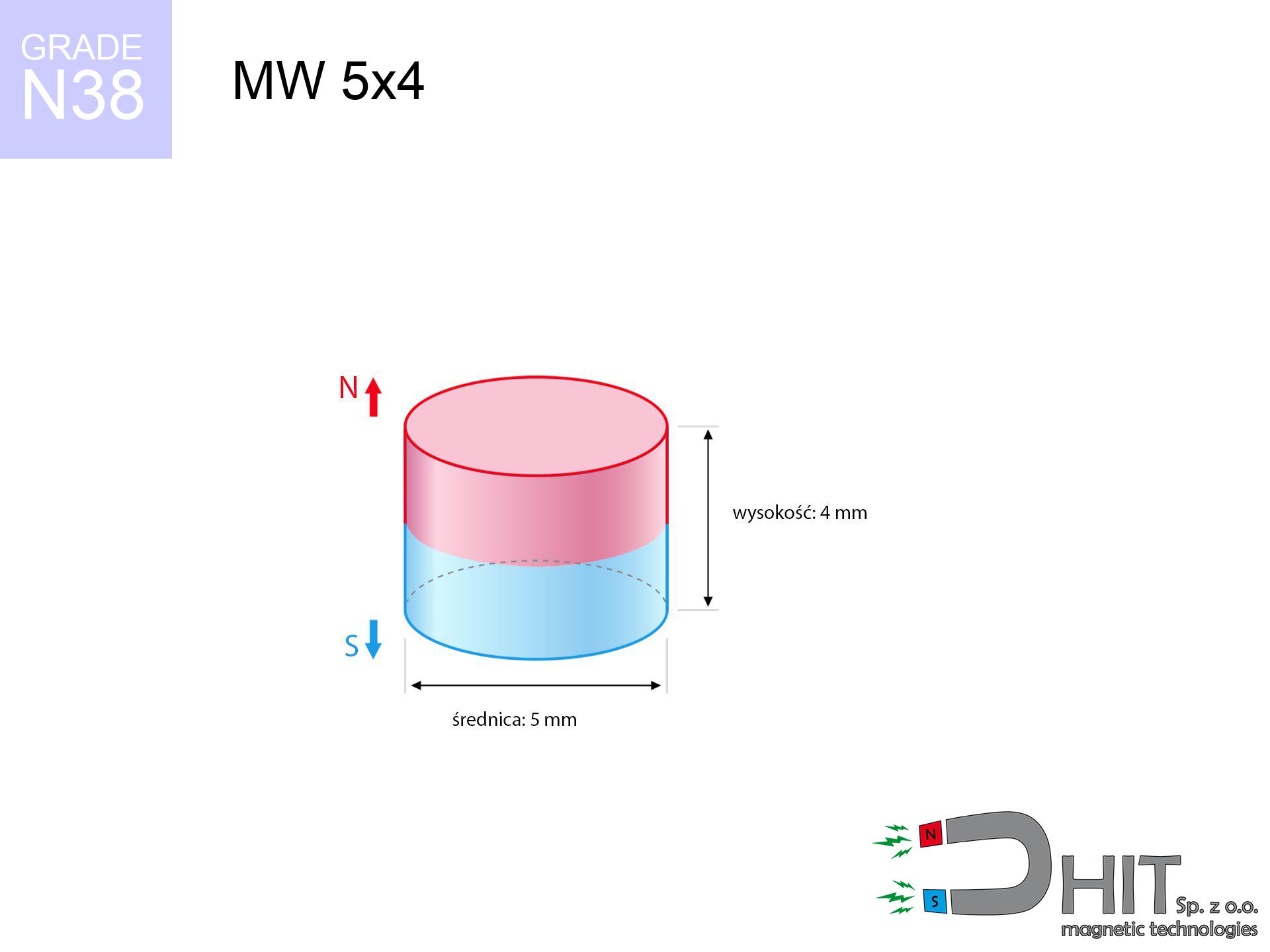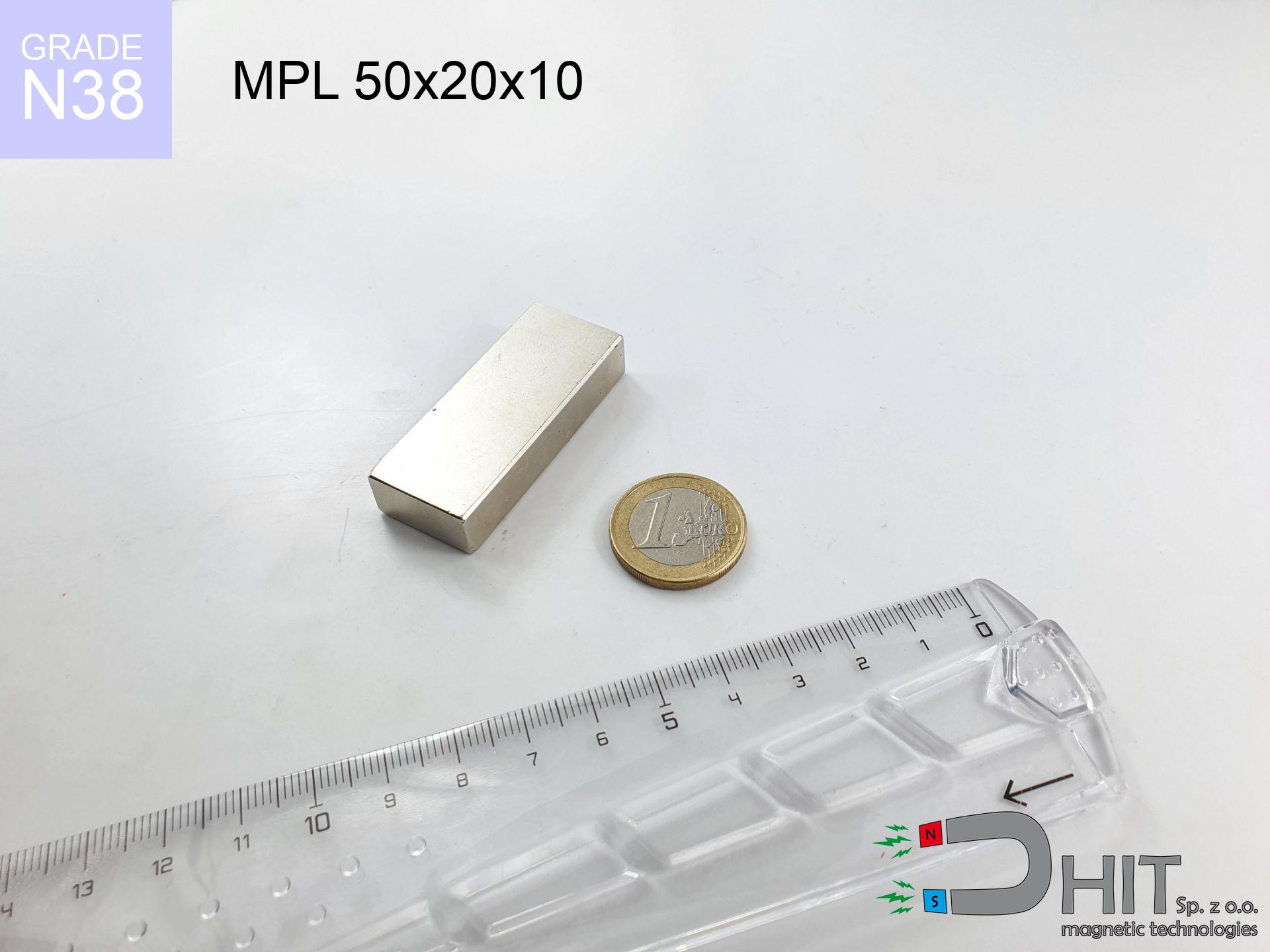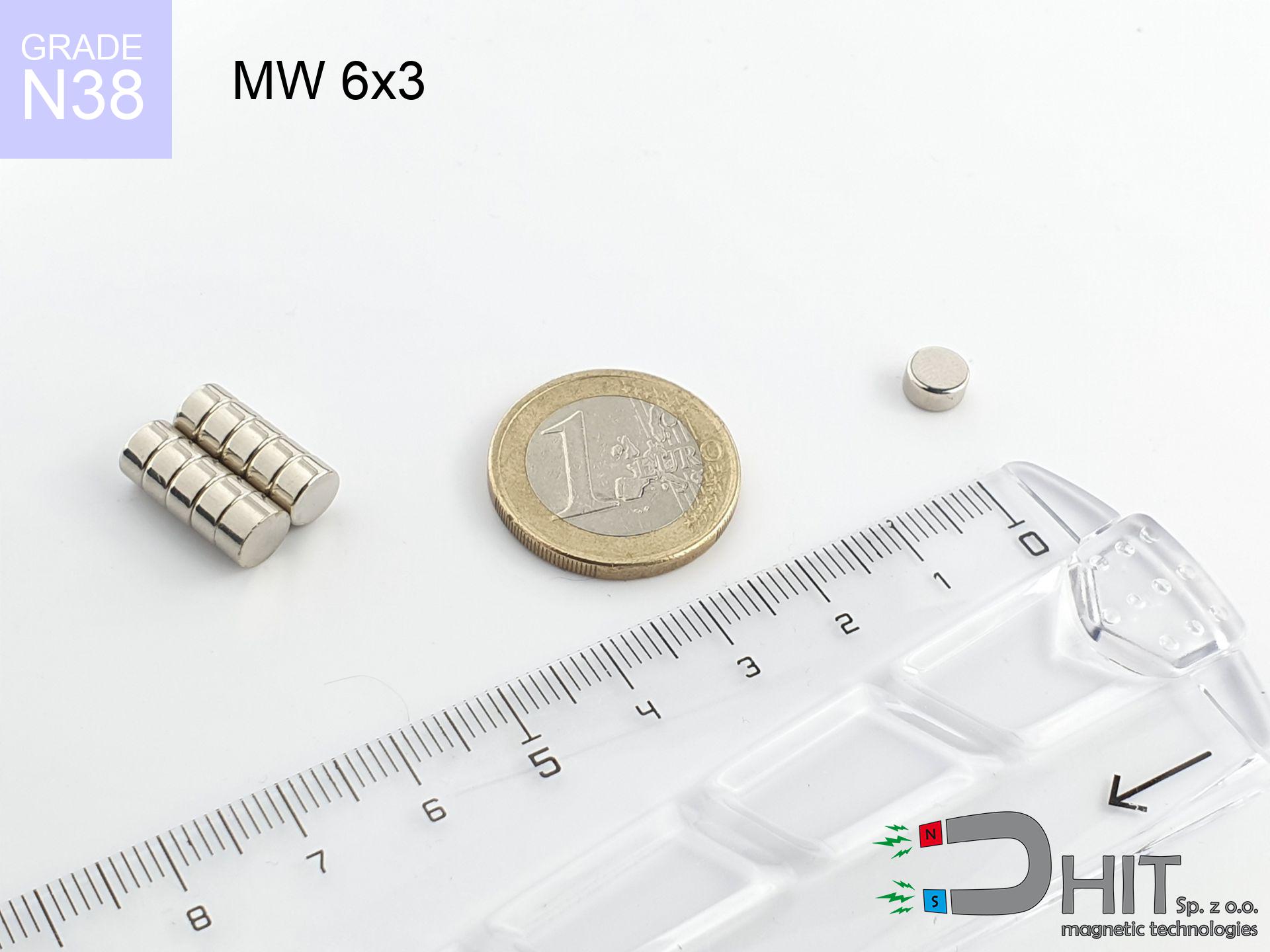MW 5x4 / N38 - cylindrical magnet
cylindrical magnet
Catalog no 010089
GTIN: 5906301810889
Diameter Ø [±0,1 mm]
5 mm
Height [±0,1 mm]
4 mm
Weight
0.59 g
Magnetization Direction
↑ axial
Load capacity
1.11 kg / 10.89 N
Magnetic Induction
524.45 mT
Coating
[NiCuNi] nickel
0.34 ZŁ with VAT / pcs + price for transport
0.28 ZŁ net + 23% VAT / pcs
bulk discounts:
Need more?Want to negotiate the price?
Call us +48 22 499 98 98 or write via form on the contact page. Test the magnet's power with our power calculator.
Orders placed by 14:00 are shipped the same day.
MW 5x4 / N38 - cylindrical magnet
Magnetic properties of material N38
Physical properties of NdFeB
Shopping tips
Moreover, although neodymium is part of the strongest magnets, they are susceptible to corrosion in humid environments. Therefore, they are coated with a thin layer of gold to increase their durability. It's worth noting that NdFeB neodymium magnets are about 13% lighter than SmCo magnets and, despite their power, easily break, which requires care during their handling. For this reason, any mechanical processing should be done before they are magnetized.
In terms of safety, there are many recommendations regarding the use of these magnets. It is advisable to avoid their use in acidic, basic, organic environments or where solvents are present, and also in water or oil. Furthermore, they can damage data on magnetic cards and hard drives, although data deletion using a neodymium magnet is not guaranteed.
In terms of properties in different environments, neodymium magnets are susceptible to corrosion, especially in conditions of high humidity. Therefore, they are often coated with coatings, such as silver, to protect them from external factors and extend their lifespan. Temperatures exceeding 130°C can cause a deterioration of their magnetic properties, although there are specific types of neodymium magnets that can tolerate temperatures up to 230°C.
As for risks, it is important to avoid using neodymium magnets in acidic conditions, basic environments, organic or solvent environments, unless they are insulated. Additionally, their use is not recommended in wet conditions, oil, or in an atmosphere containing hydrogen, as they may lose their magnetic strength.
Advantages and disadvantages of neodymium magnets NdFeB.
Apart from immense strength, neodymium magnets have the following advantages:
- They do not lose power over time. After 10 years, their power decreases by only ~1% (theoretically),
- They are exceptionally resistant to demagnetization caused by an external magnetic field,
- By applying a shiny coating of nickel, gold, or silver, the element gains an aesthetic appearance,
- They have very high magnetic induction on the surface of the magnet,
- Thanks to their high temperature resistance, they can operate (depending on the shape) even at temperatures up to 230°C and above...
- Due to the option of accurate forming or adaptation to individual needs – neodymium magnets can be produced in various forms and dimensions, which amplifies their universality in usage.
- Wide application in the industry of new technologies – find application in computer drives, electric motors, medical apparatus or other advanced devices.
Disadvantages of neodymium magnets:
- They are fragile when subjected to a powerful impact. If the magnets are exposed to impacts, we recommend using magnets in a steel housing. The steel housing in the form of a holder protects the magnet from impacts and at the same time increases its overall strength,
- Magnets lose their power due to exposure to high temperatures. In most cases, when the temperature exceeds 80°C, these magnets experience permanent loss in strength (although it is worth noting that this is dependent on the form and size of the magnet). To avoid this problem, we offer special magnets marked with the [AH] symbol, which exhibit high temperature resistance. They can operate even at temperatures as high as 230°C or more,
- Magnets exposed to a humid environment can corrode. Therefore, when using them outdoors, we suggest using waterproof magnets made of rubber, plastic, or other moisture-resistant materials,
- The use of a cover - a magnetic holder is recommended due to the limited production capabilities of creating threads or complex shapes in the magnet
- Possible danger arising from small pieces of magnets can be dangerous, in case of ingestion, which is particularly important in the context of children's health. Additionally, miniscule components of these devices are able to hinder the diagnostic process when they are in the body.
Exercise Caution with Neodymium Magnets
Keep neodymium magnets far from children.
Not all neodymium magnets are toys, so do not let children play with them. Small magnets pose a serious choking hazard or can attract to each other in the intestines. In such cases, the only solution is to undergo surgery to remove the magnets, and otherwise, it can even lead to death.
Keep neodymium magnets away from the wallet, computer, and TV.
Neodymium magnets generate intense magnetic fields that can damage magnetic media such as floppy disks, video tapes, HDDs, credit cards, magnetic ID cards, cassette tapes, etc. devices. They can also damage videos, televisions, CRT computer monitors. Remember not to place neodymium magnets close to these electronic devices.
Neodymium Magnets can attract to each other due to their immense internal force, causing the skin and other body parts to get pinched and resulting in significant injuries.
Magnets attract each other within a distance of several to around 10 cm from each other. Don't put your fingers in the path of magnet attraction, because a major injury may occur. Magnets, depending on their size, can even cut off a finger or alternatively there can be a serious pressure or a fracture.
Neodymium magnets are the strongest magnets ever invented. Their power can surprise you.
Make sure to review all the information we have provided. This will help you avoid harm to your body and damage to the magnets.
Neodymium magnetic are fragile and can easily break and get damaged.
In the event of a collision between two neodymium magnets, it can result in them getting chipped. They are coated with a shiny nickel plating similar to steel, but they are not as hard. At the moment of connection between the magnets, small sharp metal fragments can be propelled in various directions at high speed. Eye protection is recommended.
Avoid contact with neodymium magnets if you have a nickel allergy.
Studies clearly indicate a small percentage of people who suffer from metal allergies such as nickel. An allergic reaction often manifests as skin redness and rash. If you have a nickel allergy, try wearing gloves or avoid direct contact with nickel-plated neodymium magnets.
Neodymium magnets can demagnetize at high temperatures.
Although magnets have shown to retain their effectiveness up to 80°C or 175°F, this temperature may vary depending on the type of material, shape, and intended use of the magnet.
Neodymium magnets are not recommended for people with pacemakers.
In the case of neodymium magnets, there is a strong magnetic field. As a result, it interferes with the operation of a heart pacemaker. However, if the magnetic field does not affect the device, it can damage its components or deactivate the device when it is in a magnetic field.
Keep neodymium magnets away from GPS and smartphones.
Magnetic fields interfere with compasses and magnetometers used in navigation for air and sea transport, as well as internal compasses of smartphones and GPS devices.
Dust and powder from neodymium magnets are flammable.
Avoid drilling or mechanical processing of neodymium magnets. If the magnet is crushed into fine powder or dust, it becomes highly flammable.
Be careful!
So that know how powerful neodymium magnets are and why they are so dangerous, see the article - Dangerous powerful neodymium magnets.






![MPL 40x10x5x2[7/3.5] / N38 - lamellar magnet MPL 40x10x5x2[7/3.5] / N38 - lamellar magnet](https://cdn3.dhit.pl/graphics/products/mpl-40x10x5x27-3.5-miw.jpg)


